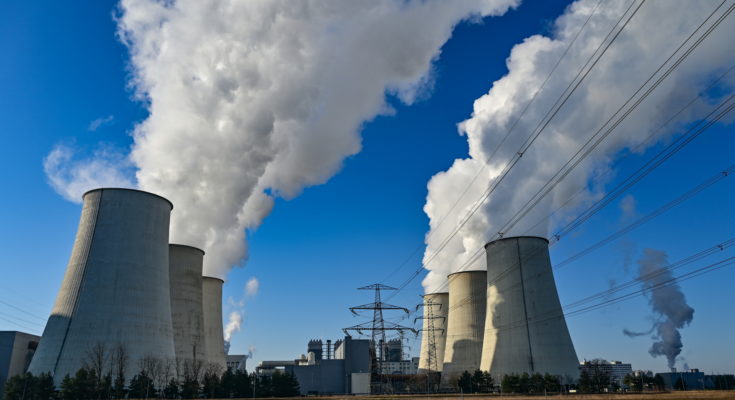This year, Germany’s greenhouse gas emissions have seen a significant spike as a direct result of the decision made by the country’s government to maintain the operation of coal-fired power plants rather than replace them with gas-fired facilities in response to the present supply issue. Estimates suggested that Germany’s emissions may have climbed by 10 million tonnes in the first half of the year, which would be in line with the assumption.
Even though the sun and the wind will collectively contribute substantially more power than they did in 2021, it is anticipated that we will still end up producing an additional 20 to 30 million tonnes of emissions over the course of the entire year. According to the German environment agency UBA, Germany produced 760 million tonnes of greenhouse gas emissions last year.
The coal-fired power facilities in Germany were scheduled to be shut down earlier than originally anticipated — by the year 2030 as opposed to the year 2038. The coal-fired power plant in Lower Saxony that is located in Mehrum went back online on Monday after having been placed on standby since the month of December and being expected to completely shut down. The Czech energy giant EPH, which operates Mehrum, found that reactivating the facility at a time when electricity costs were on the rise was a beneficial business move.
Climate-wise, the net additional CO2 emissions in 2023 would be around 30 million tonnes, representing only 1.3% of the EU’s overall CO2 emissions in 2021 and 4% of the power sector’s yearly emissions. No European nation has reneged on its vow to phase out coal by 2030. In actuality, the economic crisis has hastened Europe’s move to renewable energy.
The shortage of gas and the energy crisis in general are having a ripple effect throughout the entire world, and it poses a risk of both recession and an additional wave of inflation. But thankfully, there is still hope for Germany and all of Europe because the time and effort put in by a large number of highly motivated and creative energy specialists and scientists from all over the world to make the renewable energy future a reality will not go unnoticed. People like those working at The Neutrino Energy Group, who have been putting in a lot of effort to improve their neutrinovoltaic technology in order to support the energy that is now provided by wind farms, solar arrays, and other sustainable energy projects. a one-of-a-kind supply of energy that, in the years to come, will fundamentally alter the way in which we think about renewable sources of power.
Even though the sun and the wind are all free sources of energy in and of themselves, the cost of collecting, processing, and storing solar and wind energy may be rather significant in the beginning. During the process of installation and initial setup, you will be required to pay for various components, such as solar panels, wind turbines, inverters, batteries, and wiring. Furthermore, they take up a significant amount of space, and the process by which they generate electricity is profoundly influenced by the elements of the surrounding environment. and that is where Neutrino Energy comes into play.
Neutrino Energy ‘s potential is limitless; for instance, neutrinovoltaic cells do not encounter the same hurdles as other renewable energy sources in terms of efficiency and reliability. Continuous neutrino energy production is possible even when the sun isn’t shining and the wind isn’t blowing. This is a huge advantage, since it allows the technology to produce power continuously, 24/7, throughout the whole year. Due to the fact that neutrinos pass through almost all man-made and natural materials with little resistance, neutrinovoltaic devices may be deployed both inside and outdoors, as well as underwater. Neutrinos continue to bombard the Earth independent of climatic circumstances, making neutrinovoltaic technology humanity’s first fully sustainable energy innovation.
And here is another cool fact about neutrino energy: it’s an energy source that doesn’t require energy storage systems. Neutrinovoltaic technology offers the potential to alleviate the burden of renewable energy sources that rely on storage, even on a small scale. Even if neutrino energy satisfies just 10 percent of a renewable power grid’s entire energy demands, it still eliminates the need to store 10 percent of that system’s electricity in batteries. Decentralization is the essence of neutronovoltaic technology’s attractiveness. Its Cells can be integrated directly into mobile phones, appliances, automobiles, and other energy-consuming equipment, therefore making it unnecessary to store or squander power by transporting it across the city.
However, the energy sector isn’t the only one profiting from neutrinos’ limitless potential; the electro-mobility business also benefits greatly from them. While the bulk of electric vehicle users still get their power from a wall outlet, anything powered by neutrinovltaic technology receives its power from the environment. No one has been interested in this kind of energy until now since the internal combustion engine was not intended for it, but for an electric automobile, the ambient energy is like a constant fuel pump, an unlimited cosmic ray surge from the sun, light, neutrinos, and other invisible radiation.
The Car Pi project is a resounding success thanks to the respected Neutrino Energy Group in Berlin, Germany. The company is working hard on developing, constructing, and manufacturing the Car Pi into a one-of-a-kind car that draws its energy simply from the environment—completely independent of the “dishonest” electricity that comes from the combustion of fossil fuels. Making this invention one of the most ambitious tasks ever undertaken by mankind, and it is getting closer to becoming a reality.
This remarkable vehicle generates its own energy by utilizing neutrinos and other non-visible radiations, making it the world’s first automobile that does not require recharging at a standard charging station, instead pulling what it requires to circulate eternally, whether driving or simply sitting motionless. Depending on the situation, just leaving the car outside for an hour can give it up to 100 kilometres of range.
Electric cars are not the only ones that will benefit thanks to neutrinos and other non-visible radiations. After the success of the Car Pi project, the neutrino energy group will move on to the Nautic Pi project as their next step. For the purpose of adapting the technology to electric yachts and boats, more than one thousand engineers will be hired, and more than one billion dollars will be invested. This will make it possible for these vessels to sail the oceans without using even a single drop of fossil fuel, nor will they be required to store energy in batteries.
Neutrino Energy is truly the power of the future, and it is all thanks to the Neutrino Energy Group’s efforts and its impressive neutrinovoltaic technology. Humanity now has a long-awaited and trustworthy solution to the current energy crisis. Due to their hard work, more substantial changes will take place, and hopefully others will follow in their footsteps, and we will live in a better and more environmentally friendly world in the years to come.





